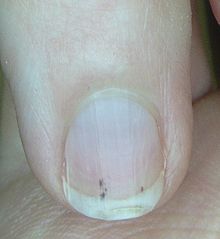Splinter hemorrhage
 From Wikidoc - Reading time: 3 min
From Wikidoc - Reading time: 3 min
| Splinter hemorrhage | |
 | |
|---|---|
| Splinter Hemorrhage | |
| ICD-9 | 703.8 |
| DiseasesDB | 27076 |
For patient information, click Splinter hemorrhage
Editor-In-Chief: C. Michael Gibson, M.S., M.D. [1]
Synonyms and keywords: Splinter haemorrhages
Overview[edit | edit source]
Splinter hemorrhages are small areas of bleeding (hemorrhage) under the fingernails or toenails. Splinter hemorrhages look like thin, red to reddish-brown lines of blood under the nails. They run in the direction of nail growth.
They are named splinter hemorrhages because they look like a splinter under the fingernail.
Pathophysiology[edit | edit source]
In certain conditions (in particular, infective endocarditis), clots can migrate from the affected heart valve and find their way into various parts of the body. If this happens in the finger, it can cause damage to the capillaries resulting in a splinter hemorrhage.
Associated Conditions[edit | edit source]
Splinter hemorrhage is a nonspecific finding and can be associated with[1][2]:
- Antiphospholipid syndrome
- Janeway spots
- Psoriatic nails
- Rheumatoid arthritis
- Scleroderma
- Subacute bacterial endocarditis
- Systemic lupus erythematosus (SLE)
- Trauma
- Trichinosis
Causes[edit | edit source]
Causes in Alphabetical Order[edit | edit source]
- Cholesterol embolization
- Endocarditis
- Psoriatic nails
- Rheumatoid arthritis
- Scleroderma
- Systemic lupus erythematosus (SLE)
- Trauma
- Trichinosis
- Vasculitis
Natural History, Complications and Prognosis[edit | edit source]
Initially splinter hemorrhages are plum-colored, but they then darken to a brown or black color in several days.
Diagnosis[edit | edit source]
The presence of splinter hemorrhages is not sensitive but is a fairly specific finding the diagnosis of endocarditis. Only one in six patients with endocarditis will have splinter hemorrhages. Therefore the absence of splinter hemorrhages does not exclude endocarditis. If there is a clinical suspicion of endocarditis and splinter hemorrhages are observed, then this is likely a fairly specific finding for endocarditis.
Physical Examination[edit | edit source]
Physical examination may include special attention to the heart and blood circulation systems.
Laboratory Findings[edit | edit source]
Electrolyte and Biomarker Studies[edit | edit source]
Laboratory studies may include:
References[edit | edit source]
- ↑ Freedberg, et al. (2003). Fitzpatrick's Dermatology in General Medicine. (6th ed.). McGraw-Hill. ISBN 0071380760.
- ↑ Rapini, Ronald P.; Bolognia, Jean L.; Jorizzo, Joseph L. (2007). Dermatology: 2-Volume Set. St. Louis: Mosby. ISBN 1-4160-2999-0.
 KSF
KSF